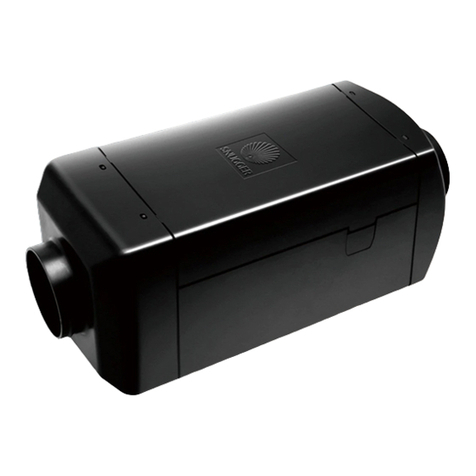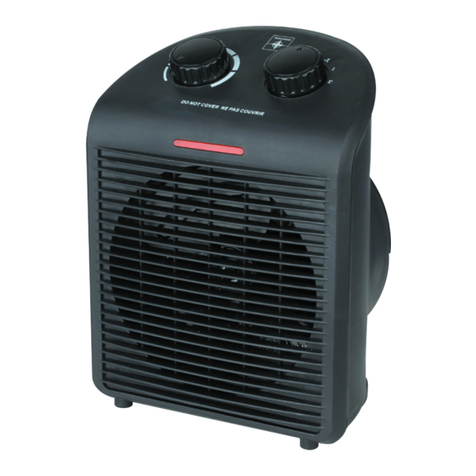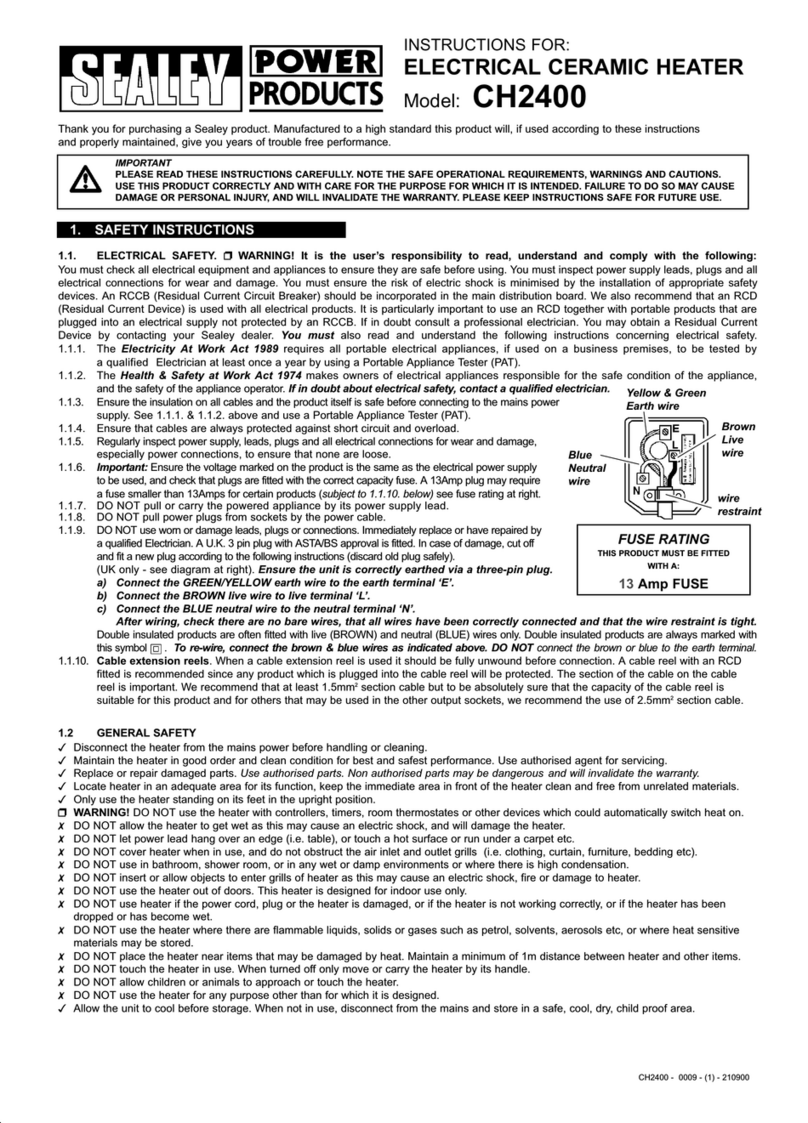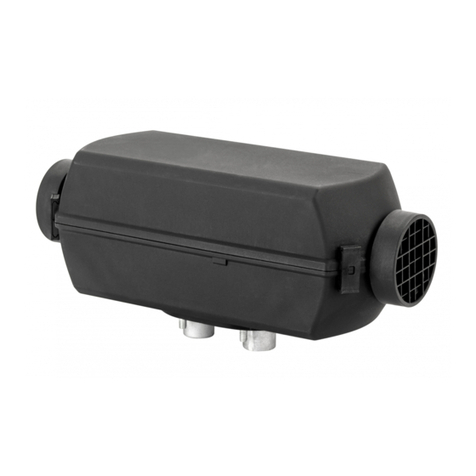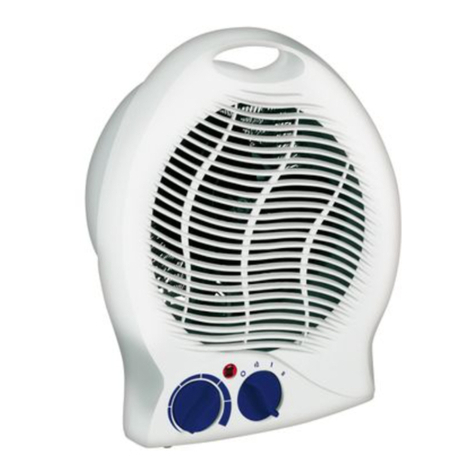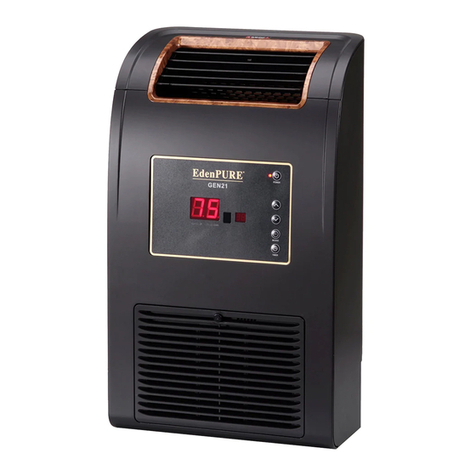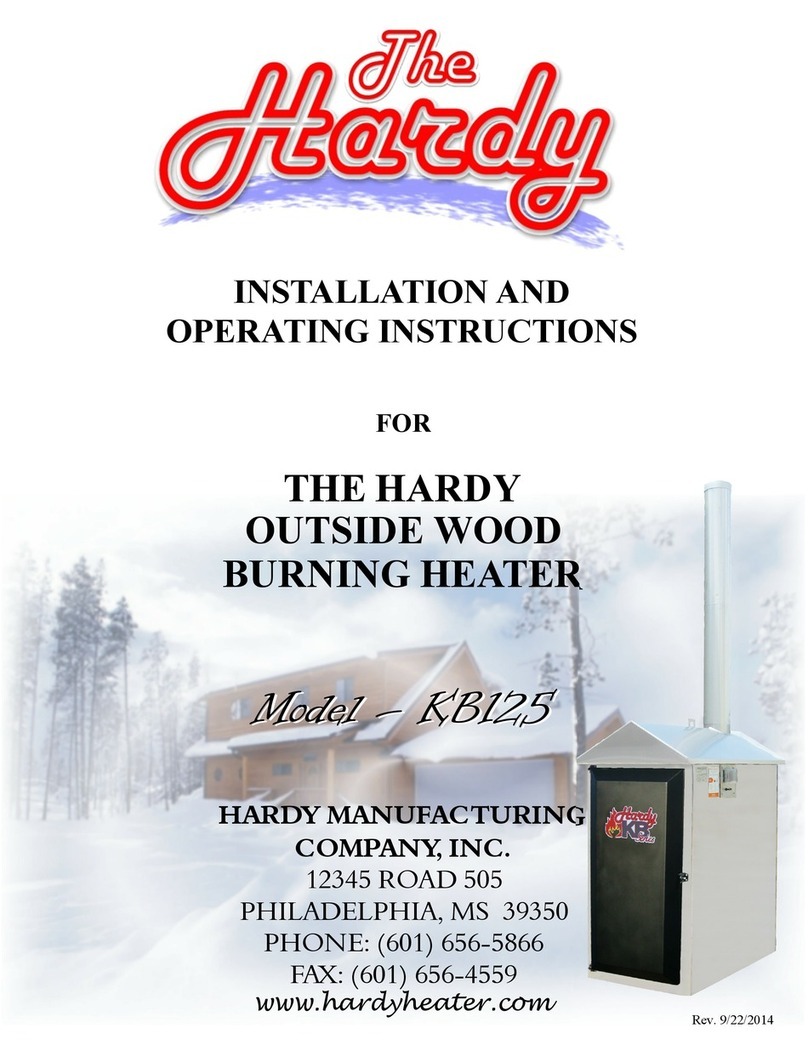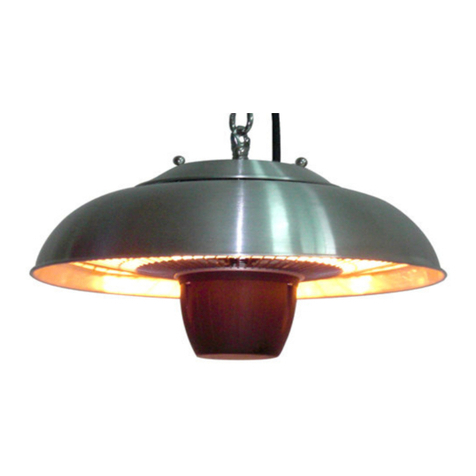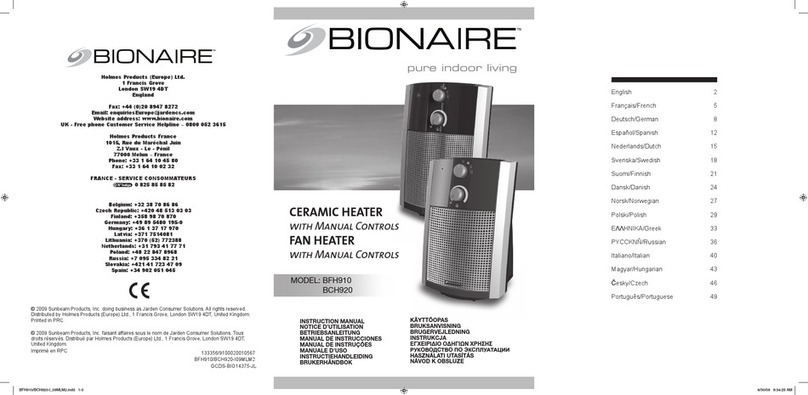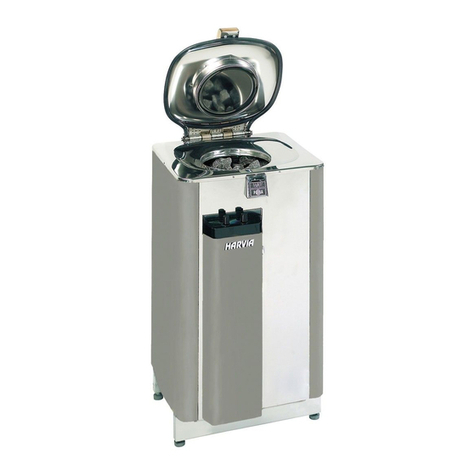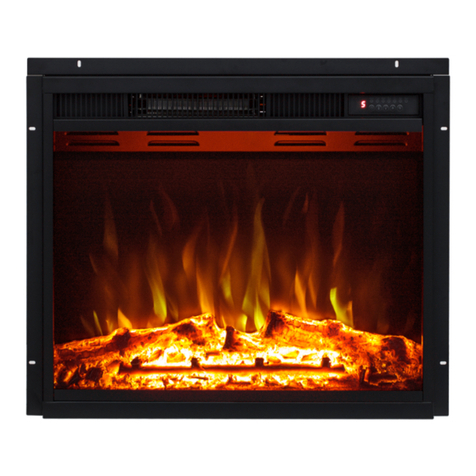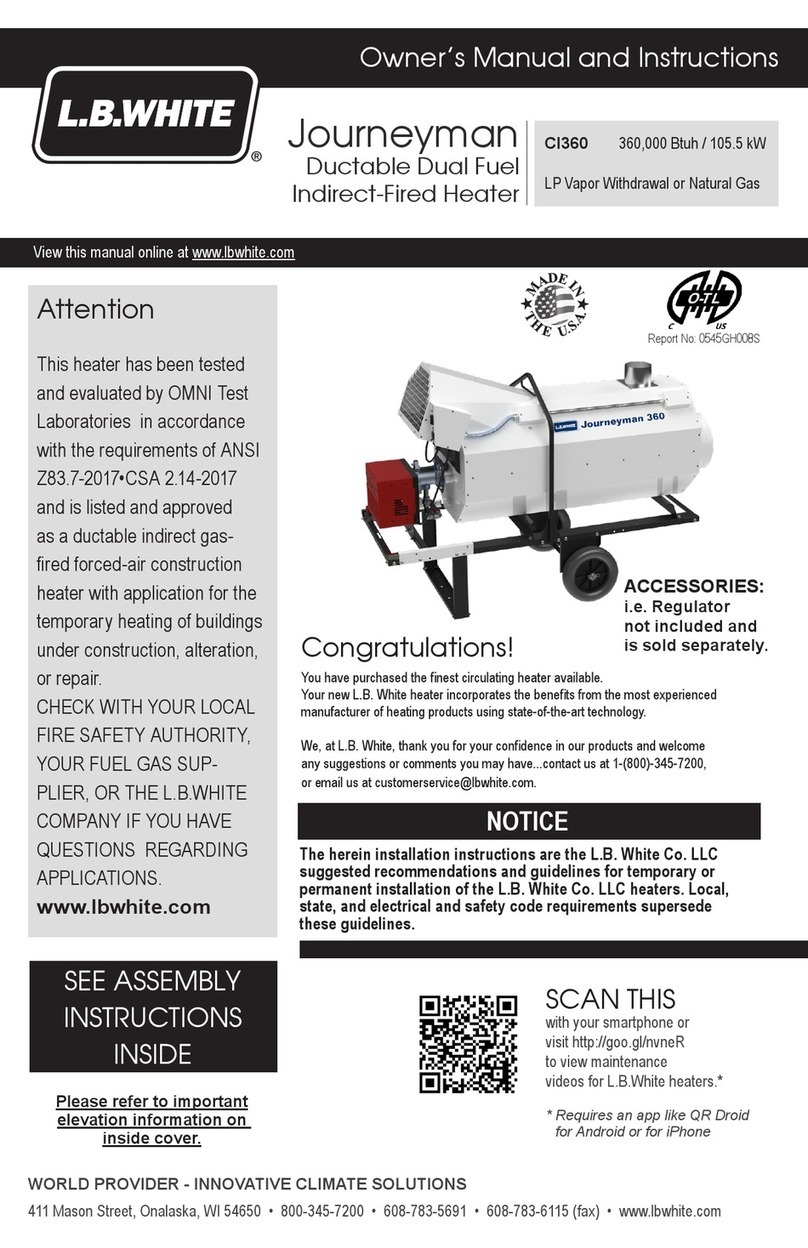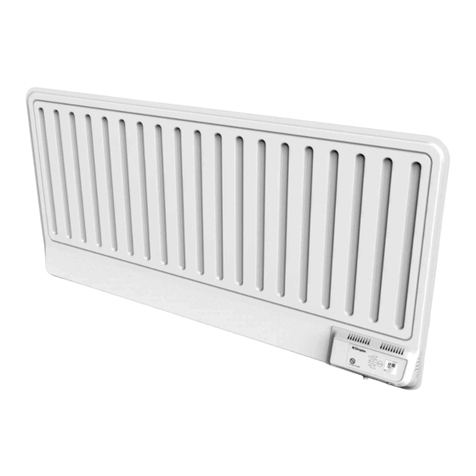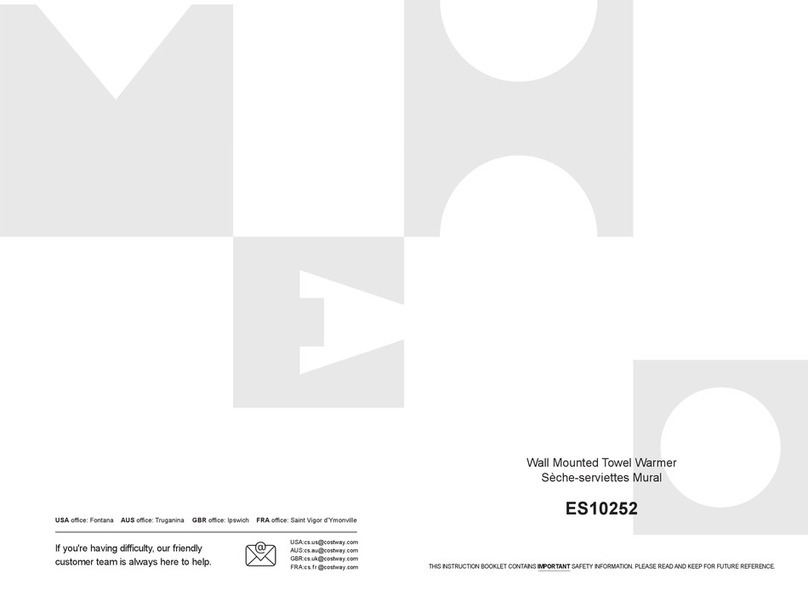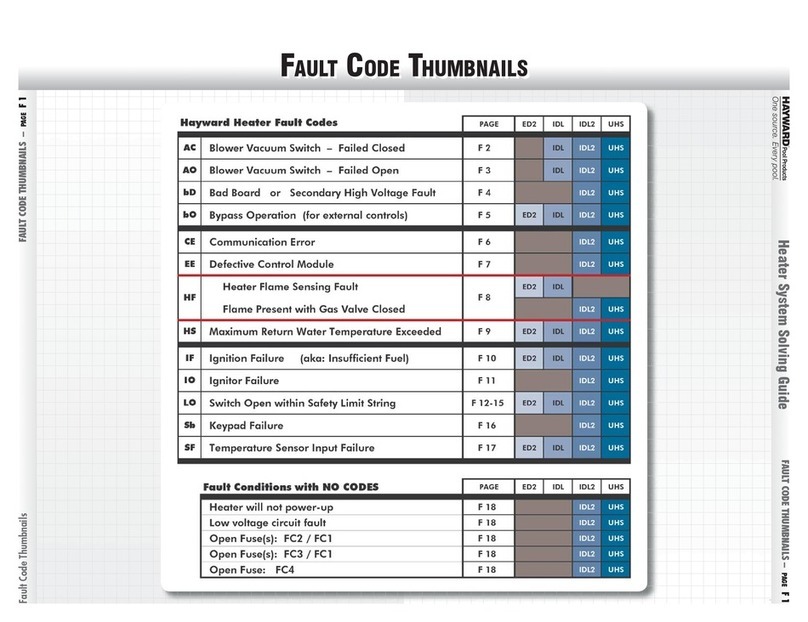Snugger SF2300 User manual

Page 1
SNUGGER
Technical description
Installation instructions
Operating instructions
Maintenance instructions
SNUGGER AIR HEATER
AIR SNUGGER USA
1 877 500-2212

Page 2
Contents
Description
Page
1. Operating Principle and Use of SS4200/SS5000 Water Heater
3
2. Main Parts
3
3. Installation Instructions and Regulations
4
4. Safety
5
5. Technical Data and Dimensions
6
6. Choosing Heater Location and Position
7
7. Connecting Heater to Water Cooling Circuit
8
8. Combustion Air System
9
9. Exhaust System
9
10. Fuel Supply
10
11. Start up and Operating Instructions
13
12. Description of Functions
13
13. Controls and Safety Device
13
14. Electrical System
14
15. Troubleshooting, Malfunctions and Maintenance
Self diagnose codes
16
16. Installation Components Diagram SS4200/SS5000
19
17. Heater Assembly Drawing SF2300 and SF4200
20
1. INTRODUCTION
◆The SF2300 and SF4200 air heaters are designed to be used as auxiliary heaters for trucks, RVs,
boats, construction and farm equipment. The heaters will provide heat and keep a comfortable air
temperature for the operator (driver) cab, small RV, passenger vans, mini buses, boats, etc for a
fraction of the cost in comparison to engine idling.
◆Automatic controls will keep the air temperature in your comfort zone.
◆Compact design, low volume, easy maintenance, safety protection, auto self diagnosis, optional
timers, wireless remote control, low emissions and low operating cost makes the heaters ideal to
use in trucks, boats, farm and construction equipment.

Page 3
2. Main parts of SF2300 and SF4200 Air Heater
2.1 Operation
◆The fuel pump delivers fuel to the heater injector. The injector evaporates the fuel and delivers
the vapors into the combustion chamber where it is mixed with combustion air. The igniter ignites
the fuel-air mixture. Burning fuel heats up the heat exchanger. The heat is transferred into
circulating air through the heat exchanger, and the warm air circulates through the truck cabin or
sleeper berth keeping it warm.
2.2 Use andApplication
◆Widely used in: cars, commercial and industrial equipment, trucks, passenger vans, buses,
motor and sail boats, and houseboats. In addition, the heaters are used for heating RV’s, travel
trailers, recreational cabins.

Page 4
3. Installation
3.1 Heater Installation
◆Select the location to place the heater, most of the time the heater is installed on the
floor or side wall under the bed in the truck storage compartment or under the seat in
passenger vans in order for the heater exhaust fumes to be exhausted directly to the
outside of the cabin or passengers space, and the warm air can be easy distributed
throughout the cabin.
◆Heater shall be protected from excessive heat, exposure, and possible
contamination from fuel or oil. Keep heater exhaust away from electrical wires, fuel
lines, water lines, and any other heat sensitive and flammable materials. Provide
sufficient ventilation.
◆All precautions must be taken when arranging the heater placement to minimize
the risk of injury or damage to property.
3.2 Fuel Supply
◆The fuel intake connections shall NOT be in the passenger compartment or
operator (driver) cabin. In vehicles where a separate fuel tank is used for the heater,
the fuel tank lines and intake connection must be clearly identified. A warning sign
shall be permanently attached to the intake connection or fuel tank indicating that the
heater must be switched OFF before refueling.
3.3 Exhaust System
◆The exhaust outlet must be arranged in a way that the exhaust fumes goes directly
to the outside of the vehicle. Prevent penetration of exhaust fumes into the vehicle
interior through the ventilation system, warm air intakes, or open windows.
3.4 Combustion Air Intake
◆The heater combustion air shall NOT be taken from passenger compartment, cargo
space or operator (driver) cabin. The air intake shall be protected from possible water,
debris, snow and ice intake into combustion chamber, and cannot be blocked by any
object at any time. Point the air intake away from vehicle travel direction.
Please Note:
◆Failure to comply with the regulations, safety instructions, repairs done by
unauthorized person, or use of aftermarket parts voids warranty and relieves
manufacture, distributors, dealers, and installation technicians from any and all
liabilities.
◆The installer is responsible for all damages to the property or person that arises
from faulty installation of the heater.
4. Safety Instructions and Operation
◆Disconnect vehicle battery power before commencing repair or performing heater
maintenance.
◆Before beginning any work on the heater, switch the heater OFF and let all hot
parts cool down.

Page 5
◆The heater shall NOT be used in: poor ventilated rooms, garages, shops,
multi-story car park, etc. Use heater only in open, well ventilated areas.
◆Use of aftermarket parts is strictly prohibited unless authorized by the
manufacturer.
◆Installation and operation of the heater shall comply with statutory regulations, safety
instructions and specifications as stated in the installation and operating instructions.
Extreme precaution shall be taken when installing and maintaining electrical wiring,
fuel supply, combustion air and exhaust system.
◆Unauthorized persons are not allowed to do any repairs or maintenance.
◆Debris and any other remains shall be removed and cleaned before reinstalling the
heater into another vehicle.
◆The heater shall NOT be used in hazardous places such as but not limited to: fuel
depots, carbon storage, timber warehouse, granaries and other places where
combustible or flammable vapor or dust may be present.
◆Heater must be switched OFF during refueling.
◆The heater shall be installed in a spacious compartment. Fuel canisters, oil cans,
spray cans, gas cartridges, fire extinguisher, cleaning rags, clothing, papers, or any
combustible or flammable materials shall NOT be stored or transported on or next to
the heater.
◆Defective or burned fuses shall be replaced only with same type and same rating
fuses.
◆In the event of a fuel leak; turn OFF the heater immediately, disconnect and cap off
fuel line. The leak is to be repaired by a professional, authorized technician.
Please note:
Do NOT shut down the heater by disconnecting the power unless required to do
so by an emergency.
WARNING!!!
Carbon monoxide monitoring sensor with alarm shall be installed in all
passenger compartments, operator or driver cabin, and sleeper berth.

Page 6
5. Technical data and specifications
Model
SF2300
SF4200
Heating value(±10%)
Btu/hr(kW)
Super
High
Medium
Low
Super
High
Medium
Low
7850
(2.3)
6485
(1.9)
4437
(1.3)
3072
(0.9)
14334
(4.2)
10921
(3.2)
7508
(2.2)
3754
(1.1)
Fuel consumption
US.gal/hr(l/h)
0.07
(0.28)
0.06
(0.24)
0.04
(0.15)
0.02
(0.1)
0.13
(0.51)
0.1
(0.37)
0.06
(0.24)
0.03
(0.12)
Fuel type
Diesel
Air flow(±10%)cfm
49
41
28
20
86
70
52
32
Electric power
consumption(watt)
(12 and 24 V)
34
23
13
9
42
32
17
11
Start-up(12 and 24 V) Watt
≤100 W
Rated voltage
12 and 24 Volt
Voltage lower limit
About 10.5 Volt and 21 Volt
time-voltage protection: 20sed
Voltage upper limit
about16 Volt and 32 Volt
time-voltage protection s: 20sed
Overheat protection
(±10%)
(115 C) 239 F
Allowed ambient
temperature
(﹣40 C ~ 76 C) -40 F ~ 168 F
Weight lb (kg)
About. 6 lb (2.7kg)
Approx.9.5 (4.3kg)
Please note:
Listed technical data is subject to the tolerances of ±10 %
5.2 Heater Dimensions

Page 7
6. Heater Location and Position
The best place to install the water heater is in the engine compartment; the heater
must be installed below minimum engine coolant level in order to allow the air to
escape and fill up the heater with water or coolant when the bleed screw is open.
6.1 Tolerable swivel range
◆Depending on the installation conditions, swivel angles should be as shown
below:
Note:The igniter —shall face upward
Please note:
In the heating mode, the heater can deviate from the shown normal or maximum
installations positions by up to +15° in all directions in order to accommodate the
vehicle or boat movement.

Page 8
Mounting heater on the floor or wall using mounting plate
Fastening the heater on the vehicle floor or wall
If the mounting surface is not smooth and even use the mounting plate.
Use sealant foam between mounting plate and wall or floor.
Cut hole in floor or wall if using mounting plate as shown on the drawing.
3. gasket
4. mounting plate
5. vehicle wall
6. washer
7. nut

Page 9
Mounting heater on the floor or wall without mounting plate.
Cut holes in floor or wall when installing the heater without the mounting plate on
smooth and even floor or wall.
Installation heater air system
(Example)
Item
Description
Item
Description
①
Safety grid
⑤
Flexible duct
1
Air intake grill
5
Flexible duct
2
Air intake lid
6
Adjustable warm air outlet
3
Air outlet lid
7
Connection fitting
4
Hose clamp
8
Air intake grill
Please note;
Safety instruction :
-Prevent possibility of sucking the engine or heater exhaust fumes into the heater.
-Protect combustible air intake from contamination with dust, salt, water, snow, ice, dirt,
oil, grease, etc.
-Prevent the warm air to be directly sucked back into the cold air return.
-Use only temperature-resistant hose (flex) for the hot air.
-Install protective cover over the heater if there are possibility that the heater may by
touched by passenger (s) or operator when heater is I use to prevent personal injury

Page 10
and also protect the heater from possible damage from cargo or contact with
flammable materials.
-Install hot air duct in the way so it is protected from possible touching by humans and
or heat sensitive materials.
-Install cold air return in the way so it will not suck the air from dirty or contaminated
environment.
8. Combustion air system.
◆Install the tube of the combustion air intake in such a way that the air intake is
protected from sucking water, snow, ice, dust, hot air, exhaust fumes or any other
debris into the combustion chamber.
◆Inner hose diameter ؾ”(20 mm) ;max. Length 55”(1.5 m),depending on the
installation conditions.
9. Exhaust System.
◆The flexible exhaust pipe inner diameter of Ø 15/16” (24mm)can be shortened to
no less than 8”(0.2m) from the heater to the silencer (muffler) but not longer than a
total of 78”(2m) including muffler; fasten the exhaust silencer (muffler) at suitable
position to the vehicle frame, route the flexible exhaust pipe from the heater to the
exhaust silencer and fasten with hose clamps. Use hose clips to attach the exhaust flex
pipe to the vehicle body.

Page 11
9.1 Safety Instruction
Warning!!!!
◆The entire exhaust system gets very hot during operation and immediately after the
heater has been working. Keep the exhaust system parts away from any flammable
materials; wires, hoses, fuel lines, carpets, plastics, brake lines, etc.
◆Maintain at least ½” air gap between the exhaust pipe and sheet metal walls in
order to prevent the heat transferring through the metal and damaging materials on the
other side of the wall. Use heat shields if necessary. Point the heater exhaust tail pipe
slightly downward, in open air, away from travel direction and at least 12”away
from any combustible or flammable materials. Tail pipe cannot protrude beyond the
lateral limits of the vehicle. Route the exhaust pipe in such a way so the exhaust
fumes cannot be sucked into the vehicle.
◆Do not perform any work on the exhaust system while the heater is working.
Before working on the exhaust system, first turn the OFF heater and wait until all
parts have cooled down completely, always wear safety gloves and eye protection.
10. Fuel Supply
10.1 The following safety instructions must be observed when mounting the fuel pump,
routing fuel lines and installing fuel tank pick-up tube.
◆
Turn OFF
vehicle engine and heater before working on the fuel supply or before
refueling. Do not use “naked” lights, open flames, do not smoke, do not inhale fuel
vapors and avoid fuel contact with skin. Work only in well ventilated area.
◆When installing fuel lines, use only a sharp knife to cut fuel hoses and pipes.
Interfaces shall not be crushed and must be free of burrs.
◆The fuel line from the pump to the heater should be installed at a continuous rise.
◆Fuel lines must be fastened to avoid damage and / or noise from vibrations.
◆Route the fuel lines in a way that they are protected from vehicle distortion,
movement, etc. Never route or fasten fuel lines to the heater or vehicle exhaust
system. When the fuel line crosses a hot element, always ensure there is sufficient
clearance. If necessary, install heat deflection plates.

Page 12
Item
Description
Item
Description
①②
Fuel intake pipe
⑤⑥⑦⑩
Fuel hose
③
Fuel pump
⑧⑨
Fuel line connecting hose
④
Fuel filter
10.2 Safety Instructions for fuel lines and fuel tanks in passenger compartment.
◆In a passenger bus,fuel lines and fuel tanks shall NOT be routed through the
passenger compartment or operator or driver’s cab.
◆Fuel tanks in passenger vehicles must be positioned in such a way that the exits
are NOT in direct danger from a possible fire.
10.3 Fuel supply for diesel heater using T connector
You may use Tconnector to tap into existing fuel line as long as the Tis installed
before engine fuel pump.
10.3.1 T fitting Setting Angle
Use the installation positions shown in the diagram when inserting a T fitting.
1Direction of flow from the fuel tank
2 Direction of flow to vehicle engine

Page 13
10.3.2 Max. suction and pressure height
Max. height from fuel tank to heater –a= 12’(3000mm)
Max. suction height from bottom of tank - b= 3.9’(2000mm)
10.4 mounting of fuel intake system
◆First, drill 2 - 1/4” (6mm) at 1 1/16” (26mm) O.C. holes in appropriate location in
top of fuel tank,as shown:
◆Then drill one 7/8” (22mm) hole as shown:
◆Mount the fuel intake system and fuel pump, as shown:

Page 14
Please note!
When drilling into the fuel tank, take precautions to prevent possible sparks from
electric tools (ground all tools).
Prevent shavings and any other debris to fall into the fuel tank.
11. Operating Instructions!
◆Before starting the heater, perform a safety check: all components must be firmly
fastened, check for fuel leaks. Bleed fuel line and prime fuel pump.
◆To start the heater; turn the control knob to “high” (turn the knob clockwise), push
heat button, the blower motor will start running. After about 60 sec. the fuel pump will
start pumping the fuel. If the fuel is not ignited in about 90 sec. (possible air in fuel
line) the igniter will shut down for about 1 min. and then it will start the process again.
The process will repeat until there is no more air in fuel line.
◆Heater at high altitudes:
1. Heating at altitudes below 5,000 ft (1,500 m), -unlimited heating possible;
2. Using heater at altitudes higher than 5,00 ft’ (1,500 m) requires installing an
altitude pressure sensor.
12. Description of functions
12.1 Operation
◆When the heater is turned ON, the control lamp comes ON. The combustion
air blower starts running, the igniter will starts heating up, and fuel pump starts
pumping fuel. Once the flame is stable, igniter will turn off.
12.2 Heating mode
◆Once the air reaches the desirable temperature the heater will turn OFF, the
combustion fan will run for apx. 2 min. in order to evacuate exhaust fumes and
cool off the combustion chamber. The heater fan will continue to operate on the
low speed. The heat light will stay ON. The heater will restart after the air
temperature drop below setting point.
13. Controls and Safety Device
◆If the heater does not ignite within 90 seconds after starting the fuel pump, the start
process is repeated several times. After several unsuccessful starting attempts the
controller will lock the system in order to prevent fuel flooding the chamber. You can
restart the process by switching the heater OFF and then ON again.
◆If the flame goes off during operation, the heater will restart by itself. If the heater
does not ignite after several attempts to restart, the heater will lock and it will need to
be turned OFF and ON manually.
◆In the case of overheating (for example, debris clogging the cold air intake, poorly
vented warm air), the overheating sensor is triggered, the fuel supply is interrupted and
the heater turns OFF. Once the overheating has been eliminated, the heater can be
restarted manually by turning OFF and ON again. If the heater has been switched OFF

Page 15
and ON too many times in short period of time, the controller will lock, wait for about
15 min. and turn the heater ON again.
◆If the lower or upper voltage limit is reached, the heater will turn OFF.
◆The heater does not start when the igniter is defective or when the fuel pump power
is interrupted.
◆The fan speed is continuously monitored. If the fan motor does not start or if the
speed deviates by more than 40%, the heater will turn OFF after 60 sec.
◆The controller can be enabled again and it will flash fault code:
◆Use chart below to read the fault code list.
◆Do not switch the heater OFF and ON again more than twice.
Please note!
Emergency shut down
In event of an emergency, shut down the heater as follows:
1. Try to turn the heater OFF with the control panel.
2. Pull the fuse out.
3. Disconnect battery power.
14 Electrical systems
14.1 Wiring of the Heater
Safety Instruction for wiring the heater
The
Heater shall be connected to the power according to the EMC
requirements. See instruction below;
1.
Ensure that the electric cable’s insulation is not damaged. Avoid: chafing,
kinking, jamming or exposure to heat.
2. Seal all unused connector chambers with filler plugs to ensure they are dirt and
water-proof.
3. All electrical connection shall be free of corrosion and firmly connected.
4. Lubricate all outside connections with contact grease.

Page 16
Electrical
Electrical diagram
SI/N
M
Θ
Θ
Θ
ECU
red
bleck
brown
orange
yellow
amethyst
glow pin
blower
Outlet air sensor
burner sensor
Inlet air sensor
bleck
red
℃
HEAT
OFF
FAN
bleck
GND
GND(-)
B
GND
FU2
FU1
Annex list
Wire color
Function
Wire color
Function
Red
DC 12V/24V (+)
Brown
line of communication A
Black
GND (-)
Orange
line of communication B
Yellow
Starting line
Amethyst
Fuel pump line (+)
Control module
glow pin
blower
GND(-)
Inlet air sensor
burner sensor
outlet air sensor

Page 17
15. Troubleshooting, Malfunctions and Maintenance
15.1 Malfunction checklist.
Heater does not start after being turned on; switch the heater OFF and ON again.
If the heater still does not start, check the following:
- is there fuel in the tank?
- are fuses ok?
- are electrical cables, all connections, etc OK?
- is anything clogging the combustion air supply or exhaust system?
- does the control panel flash the fault code?
15.2 Troubleshooting diagnosis chart
Please record the number of closed when the lamp is flashing, while the heater function
failure. Then check the list 4.1 and shoot trouble.
List 4.1
Code
flashing
times
Description
Solution
1 time
The power supply voltage too high
Check the voltage, possible alternator drive belt
too loose, check charging system
2 times
The power supply voltage too low
Check the voltage, charge battery, check charging
system
3 times
The burner temperature sensor
malfunction
Check the temperature sensor connection and
position whether it is correct;
Check the temperature sensor wires for possible
damage or short.
4 times
Inlet air temperature sensor is fault
5 times
Outlet air temperature sensor
malfunction
6 times
Igniter malfunction
Check the voltage between igniter terminals it
should read 12 or 24 V.
Check for broken wires and loose connection,
shorting out wires.
Remove and check the igniter for any visible
damage; replace igniter if damaged
7 times
Fuel pump malfunction
Check the voltage at fuel pump.
Check wires for damage and connections and
short circuit at fuel pump.
Check fuel pump for any damage.
8 times
Blower malfunction
Check blower wires for damage and proper
connections.
Check blower for any visible damage.
10 times
Ignite fail or flame extinguish
protection
Check whether there fuel in tank.
Check all fuel connections.
Check if fuel pump is working.
Check if the igniter is working normally.
Check if the air inlet/exhaust is blocked.
11 times
Burner overheating protection
Check the fuel pump pressure.
Defective fuel injector

Page 18
12 times
Outlet warm air temperature
overheating protection
Check the return inlet air and warm outlet air for
blockage.
13 times
Flame extinguished or burner
overheating forbids the system
operation
Disconnection power and re-connection again.
14 times
Communication fault
Check all wire connection.
To reset the system:press down “OFF” button →waiting for 15 minutes, it should clear the
fault codes, turn ON the system. If the system does not clear the code, disconnect battery
power, wait few minutes, hook up the battery power and turn the system ON
15.3 Maintenance Instructions
◆switch the heater ON once a month for about 10 minutes, even if there is no
need for heat.
◆check the opening of the combustion air supply and the exhaust system after longer
standstill periods; clean if necessary.
◆Before the heating period starts the heater should undergo a trial run. If persistent
extreme smoke, unusual burning noises or unburned fuels smell develop or if electric
/electronic parts heats up, the heater shall be switched off immediately. Remove fuse
or disconnect battery power.
◆have the heater checked by authorized, trained service technician.
Please note:
The warranty claims will become void if the heater is repaired or serviced by an
unauthorized person.

Page 19
Figure 5.1

Page 20
Item
Parts No.
Description
Qty
1
SF2-000205
Air outlet
1
2
SF2-000310
Temperature sensor
1
3
SF2-000108
Clamp spring
1
4
SF2-000202
Top cover 1
1
5
SF2-000203
Rubber grommet
1
6
SF2-000106
Seal washer
1
7
SF2-000110
Burner assembly
1
8
SF2-000105
Grommet
1
9
SF2-03
Glow pin
1
10
SF2-000107
Cap ,glow pin
1
11
SF2-000115
Burner filter screen 1
1
12
GB/T2672-1986
Pan head screws M5X10
3
13
GB/T818-1985
Pan head screw M4X10
2
14
SF2-000500
Control unit
1
15
SF2-000204
Air inlet hood
1
16
SF2-000206
Grill
1
17
GB/T2672-1986
Pan head screws M5X25
4
18
SF2-000208
Hot air blower wheel
1
19
GB/T93-1987
Spring washer 6
4
20
SF2-02
Motor
1
21
SF2-000102
Heater exchanger coping
1
22
GB/T818-1985
Cross recessed pan head screw
M4X20
3
23
SF2-000103
Washer, heat exchanger
1
24
SF2-000104
Combustion air blower wheel
1
Other manuals for SF2300
2
Table of contents
Other Snugger Heater manuals

